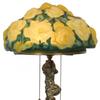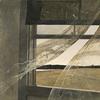Huntington Acquires Unique Edition of John Muir’s Writings With Herbert Gleason Photographs, and More
- SAN MARINO, California
- /
- February 01, 2017
The Huntington Library, Art Collections, and Botanical Gardens announced Wednesday that it has acquired a unique 10-volume edition of The Life and Writings of John Muir (1916–1924) that incorporates 260 original photographs—most by Herbert W. Gleason (1855–1937), a nature photographer who inspired the work of Ansel Adams. The items were purchased at The Huntington’s 20th annual Library Collectors’ Council meeting held last month.
The Council also purchased A Monograph on the Genus Camellia (1819), an outsize volume containing sumptuous hand-colored aquatint plates after watercolors by Clara Maria Pope (d. 1838), one of a small number of women in England who pursued an artistic career in the late 18th and early 19th centuries.
Additional purchases included manuscripts by a close member of Galileo’s circle and by a U.S. Revolutionary War officer, as well as a genealogical roll of arms from the Elizabethan era.
“During the past two decades, the Library Collectors’ Council has helped us acquire more than 100 significant items—including rare books, individual manuscripts, archival collections, and photographs—and spent nearly $3.9 million doing so,” said David Zeidberg, Avery Director of the Library at The Huntington. “We are enormously grateful to the Council for their generous support over the years.”
The Library Collectors’ Council is a group of 43 families who assist in the development of the collections by supporting the purchase of important works that the Library would not otherwise be able to afford.
Highlights of the newly purchased materials:
The Huntington’s deluxe, one-of-a-kind edition of The Life and Writings of John Muir includes an original Muir manuscript and a color frontispiece in each of the set’s 10 volumes, as well as 260 original photographs, most of them by Gleason. It is an important addition to The Huntington’s extensive collections in early environmentalism and in early California photography, which include works by Carleton E. Watkins, Edward Weston, and Ansel Adams, and sets the stage for the role of fine art photography in service to the preservationist cause.
Throughout his life, Scottish-born naturalist and philosopher John Muir possessed an unquenchable passion for nature. By the time of his death in 1914, many Americans sympathized with his vision of the everlasting unity of all living things and endorsed the necessity of preserving wild spaces. Muir’s tireless championing of the Yosemite Valley and California’s Sierra Nevada contributed to securing them as part of the Golden State’s legacy of natural wonders.
“Muir was an assiduous student of all things living and poet laureate of California’s forests, lakes, and mountains—as well as an unswerving advocate of wilderness,” said Peter J. Blodgett, H. Russell Smith Foundation Curator of Western American History. “He exemplified a radical transformation in the perspective through which humans envisioned the natural world.”
Following Muir’s death, his daughters asked his good friend William F. Badé, a faculty member at the University of California, to prepare an edition of their father’s principal literary works. Published by Houghton Mifflin between 1916 and 1924, the 10-volume set involved the collaboration of Gleason, another close friend of Muir’s.
Gleason was based in Massachusetts but spent much of his adult life traveling around North America with a camera and notebook. An extended visit to California and the High Sierra in the summer of 1907 brought him into contact with Muir, and a meaningful association was born. Gleason went on to become one of the most capable and prolific nature photographers of the early 20th century.
“While this unique assemblage of The Life and Writings of John Muir was perhaps created at the behest of a subscriber, research suggests that its inspiration came from Gleason himself,” said Jennifer Watts, curator of photography and visual culture. “The photographer’s imagery influenced a range of early practitioners, including a young Ansel Adams, and its eloquence is on powerful display.”
A Monograph on the Genus Camellia is a landmark work of horticultural literature that contains what are probably Clara Maria Pope’s best-known botanical illustrations.
Pope’s first husband, Francis Wheatley (1747–1801), was a portrait, landscape, and genre painter, and his debts prompted Pope herself to turn to art to support their family. She taught drawing and sold her own art as well, sending her first painting to the Royal Academy in 1796 and continuing to exhibit there until the year of her death. After 1812, she devoted herself almost exclusively to flower painting and botanical art, in which she excelled.
Pope’s vivid watercolors of camellias were engraved for A Monograph on the Genus Camellia, with text by Samuel Curtis (1779–1860), the son-in-law of William Curtis (1746–1799), founding editor of Botanical Magazine. The plant had been cultivated in England since before 1739, and the monograph lists the 29 camellias known there at the time of publication. Curtis discusses in full the 11 varieties of Japan Rose illustrated in Pope’s five flamboyant yet scientifically informative plates, as well as the propagation and culture of camellias. Sitwell and Blunt’s Great Flower Books, 1700–1900 calls the publication “one of the earliest and probably the best of all the great camellia books.”
“Curtis and Pope’s splendid volume exemplifies The Huntington’s trinity of books, art, and gardens,” said Claudia Funke, chief curator and associate director of library collections.
The Huntington has one of the most comprehensive collections of camellia plants in the world, including nearly 80 species and 1,200 cultivars. Extensive library holdings enhance the plant’s study, most notably more than 100 rare camellia books.
Pope’s achievements are also in context with The Huntington’s outstanding British art collection, which holds more than a dozen works by her first husband, Francis Wheatley, including a pair of group portraits on display in the dining room of the Huntington Art Gallery.


270x400_c.jpg)










100x100_c.jpg)


